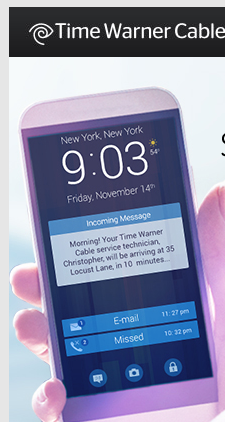 On the left is a partial screenshot of an October email pitch to me by Time Warner Cable, here in Manhattan. (It’s also on the Web, here.) On the whole, it looks good: service on demand, on my terms, when I need it.
On the left is a partial screenshot of an October email pitch to me by Time Warner Cable, here in Manhattan. (It’s also on the Web, here.) On the whole, it looks good: service on demand, on my terms, when I need it.
Or, I thought, maybe. Because I was suspicious. Time Warner Cable’s customer service reputation was awful. And I’m always on alert for BS. For example, hold time was “reduced” (to what?) and suspected the 24/7 “live agent” was not a human being.
Then there was the “My TWC® app.” Why should I clutter my mobile device with an app from every company I deal with, especially when I hardly ever deal with them?
And then there was the “Ask TWC Virtual Assistant”: http://www.timewarnercable.com/en/support/contact-us.html
Hey, if I want a virtual assistant, it should be my employee, not TWC’s, or any other company’s. (Here are the VRM ones.)
But I was game, so I looked for MyTWC on Apple’s App Store, and found nothing there — not by “My TWC”, “TWC” or “Time Warner Cable”.
Then I decided to dig into the TWC site for more. Naturally, I needed a login and password. I didn’t know what those were, and when I tried to recover a login, I got this:
TWC ID System Error
Error Code: EXCEPTION Reference ID: 4FFUT-5327B-RH4L4-2RDQD-N4WET.
So, in case I never registered (I didn’t remember), I tried doing that. The result:
A TWC ID already exists for this account. If you are the primary account holder and did not register for a TWC ID, please contact us. Chat with us.
— with a link under that last sentence.
Before I chatted, I needed to give the agent my full name and phone number, and then choose the topic. My choices:
Topic: *
New TWC ID Help
Reset TWC ID Login
Not especially clear, but I hit the former.
What then followed was the best customer experience I’ve ever had with an ISP. Two chat agents, in succession, gave me exactly what I was looking for, and more. I quickly recovered the login and password. I got the right link to the app, which I downloaded and installed. Then I found, after asking what speeds I should be getting for the $109/month I’m spending, that it’s 300MBps down and 20MBps up. When I found that my speed (over Ethernet, directly through the router) was 50/5, I was told that my modem (a Motorola SurfBoard SB6121) couldn’t handle the promised speeds. The agent even gave me tech reasons I doubt any robot could give. Then the agent sent me to a page with a list of cable modems that can handle the speeds I’m buying. (Here’s a .pdf version.) All were about $95 on Amazon and elsewhere. So I ordered the Netgear CM500-100NAS, which seemed to have the most good reviews — helped along the way by the chat agent, who told me to call back when the unit arrived.
I did that, and booked a technician to show up and help install the thing early the next Monday morning — exactly as promised in the email above. When the guy got here, he not only got the thing set up well, but helped me select a channel on my Apple Time Machine/wifi hotspot that had minimal interference from activity coming from the high-rise next door. (The list of wi-fi signals in the drop-down menu of my laptop can get longer than the screen is high.) And to set up the hot spot so it gave both 5GHz and a 2.4GHz. The former was faster here in my office, while the latter had better range to the other end of the apartment. Here is the final post-tweaking test result in my office, from DSL Reports’ speedtest, which is currently the best in the business:

Not what I expected.
So hats off to TWC. Well done.
Now for the VRM side of this.
We know from our friends in the CRM, CX, CE, IA and other overlapping customer services worlds on the supply side of business that there is now friendliness toward VRM approaches that standardize and normalize the way each of us connects to the companies that serve us.
How do we meet in a middle? More about that in the next post — and in comments below, if you like.
